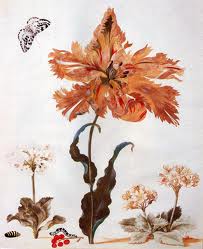Maria Sibilla Marian independently studied the molting cycle of butterflies and other insects, and even traveled in 1699 to Suriname in South America, at the age of 52, to document the local plants and insects. However, more than 150 years before Darwin, she did not know about evolution and wrote in the introduction to one of her books that research was aimed at discovering God's secrets in nature

Maria Sibylla Merian, 1647-1717) was one of the greatest nature artists of her time.
From childhood she was fascinated by the life cycle of butterflies, and made a close study of their reincarnations. She became a flower painter and teacher in Nuremberg, Frankfurt and Amsterdam.
Her first book, Neues Blumenbuch (New Book on Flowers) was published in 1675-1680. Painting single flowers or a bouquet of flowers was used as a template for amateur painters or as a handicraft for ladies. The book continues a tradition of similar works started by her father at the publishing house.
In these gardens Marian began to study insects, in particular the life cycle of caterpillars and butterflies. Many educated people at the time believed that the insects came from the spontaneous creation of rotten mud", an Aristotelian idea that persisted despite or perhaps because of his teaching at the hands of the Catholic Church. Although Thomas Aquinas concluded that the spontaneous creation of insects was the work of Hestan, Pope Innocent V in the 13th century declared that the belief in spontaneous creation was contrary to the teachings of the Church, because life was created on the first day of creation as recorded in Genesis. However, the Greek tradition prevailed mainly in parts of the scientific community.
Francesco Redi was among the scientists who showed that worms are born from eggs. Contrary to popular opinion, Marian investigated what really happens in the transition between the different incarnations of the insects, and in addition also learned details about the pupae and plants used for food. Later, she collected the drawings and drawings of the stages of development in a book she published.
In 1678, her second daughter, Dorothea Maria (later the wife of the diplomat George Gesell), was born and a year later she published the first volume of her second book called The Miraculous Transformation of Caterpillars and Their Strange Plant Food. In this book she presents the stages of the incarnations of different species of butterflies along with the plants they feed on. In the introduction to the book, she asks the readers not to look for her glory in this, but to praise God as the creator of the small and humble worms. The label was "The caterpillar book" - a book intended for reflection and not a scientific book. He maintained the tradition of seeking God in nature.
In 1681, Jacob Marl, the nobleman who supported her, died and his family returned to Frankfurt in 1683 to take care of the assets, including the house, the works of art, the library, and the financial issues that remained open at the time of his death. Because of this, Marian, her husband and her daughters had to move to live in a religious commune - the Labdists, who accepted only married couples as members. The family moved to a house that belonged to Cornelis van Sommelsdyk, governor of Suriname. There she first heard about the flora and fauna of South America.

Five years later her mother died and she moved to Amsterdam. Her husband divorced her two years later in 1692. In Amsterdam Marian and her work attracted the attention of several scientists. Her eldest daughter, Johanna Helena, married the merchant Jacob Harlot, also a former member of the Levadist sect, and moved with him to Suriname, which was then the newest Dutch colony that had just been acquired.
Inspired by butterflies and dried exotic flowers that came to Amsterdam from the Dutch colonies and were stored in the historical collections in the Netherlands, in 1699, at the age of 52, she made a trip to Surinam (Dutch Guiana) in South America. The purpose of the tour was to explore the rare flora and fauna in the tropical habitats. Upon her return to Amsterdam two years later, she began working on the preparation of a prolific illustrated guide, Metamorphosis insectorum Surinamensium (The changes of form of insects in Surinam, published in 1705. The book describes the life cycles of the insects of the area.
Most of the watercolor paintings she painted were copied into quality prints from the plates from which the book was printed. The 95 Marian prints in the British Royal Collection were bought in 1755 by King George III, when he was still the Crown Prince or Prince of Wales.
